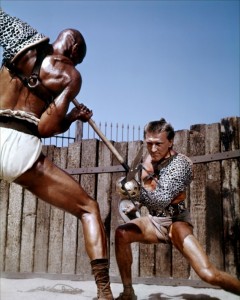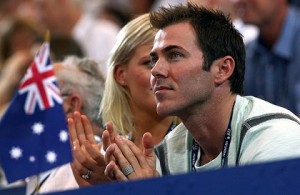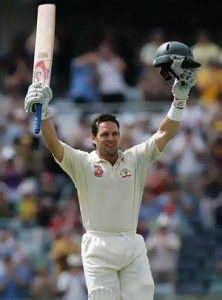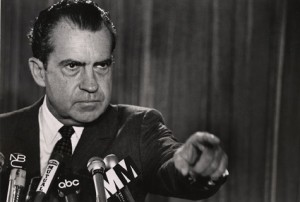
A gradual but inevitable descent into cricket-based loathing and bile.
Whatever Happened to the Unlikely Lads (International Edition)? #11: Brad Hodge
They tell many stories south of the Murray River. Like how Australian Rules Football, a spectacle that has been described as akin to watching a pack of seagulls fight over a chip, is the greatest sport in the world. Or how drafty cramped alleys full of over priced cafes lend Melbourne a ‘European air’. But their most cherished tale, one we imagine is often heard around camp fires on cold winter nights, is that of the brown paper bag. That is, whenever a cricketer makes his debut for New South Wales, along with his cap he is handed a brown paper bag that contains a baggy green. That way, so it is said, the national selectors save themselves the hassle of two presentations.
It must be difficult to maintain such an attitude of bitter resentment, yet Victorians are typically dogmatic in their perseverance. A national conspiracy exists to deny opportunities to their best and brightest cricketers. One player perfectly personifies this grudge against their seemingly more favoured northern neighbours. One of the finest players of the last decade, whose sum total of international appearances was limited to 25 ODIs and a mere six Tests, and whose retirement was surrounded with the sort of anger that Simon Katich would be proud of. Today, we celebrate the career of one…
#11: Bradley John Hodge
It might seem somewhat surprising in retrospect that the Australian Test team was able to maintain such a high standard of performance throughout much of the 1990s and 2000s. John Buchanan would like to think that it was mostly the result of his positive thinking exercises and ‘crystal healing’ sessions. In truth it was because the standard of the Sheffield Shield competition kept the Test players sober. Even players of the calibre of Glen McGrath and Shane Warne would have been wary of a return to domestic cricket, where they would have been faced with the prospect of empty stadiums and batsmen like Matthew Hayden, Justin Langer and Darren Lehmann. Shield cricket throughout this period was a killing ground for reputations.
During this period Brad Hodge was just one of a litany of promising batsman in Shield Cricket (utterly unlike today’s mob of no-hoper’s). After making his debut in 1993 he proceeded, like many others such as Martin Love and Stuart Law, to accumulate mountains of runs in domestic cricket, all the while biding his time and waiting for a moment of weakness and a hint of blood so he could pounce on one of the established Test players. Over time, as many of his colleagues either made the step up or retired into relative obscurity, Hodge emerged as the next big thing; the best batsman in the country outside of the Test squad. It was a mantle he was destined to wear for many years.
Perhaps the single determining factor that kept Hodge on the fringes for so long, despite consistently impressive performances, was his batting style. Hodge was something of an obdurate compiler of runs, inclined towards occupying the crease for long periods at a time, as Shield bowlers were well aware. The Test team, however, ever since the captaincy of Mark Taylor, was focused on playing attacking cricket. Even on the few occasions they were forced onto the defensive their first thought was to counter-attack. Such a philosophy favoured flamboyant stroke players in the middle order, batsmen such as Mark Waugh, Damien Martyn and Michael Clarke, who could take a game away from the opposition inside a session.
When Hodge finally broke into the Test team, in the summer of 2005, the clash of styles manifested itself in the most spectacular way possible. In his third Test match, and the first in a three Test series against the touring South Africans, Hodge anchored the Australian second innings, which they began 38 runs in arrears, with his maiden Test century. A double century to be specific, scoring 203* in a total of 528/8. Set 491 to win, the South Africans managed to survive the final day with some comfort, ending on 287/5. For a team accustomed to winning and not satisfied with fighting draws a culprit needed to be found, and surprisingly (in some quarters) that proved to be Hodge. His innings, it was argued, had been too slow, although he did score at a healthy strike rate of 61, and therefore had given the bowlers too little time to shift the stubborn South Africans. Ponting’s captaincy also came in for criticism as he was slated for granting Hodge too much time to complete his double century before his declaration. Whatever the truth of the matter, Hodge lasted the rest of the series only to be dropped at its conclusion, despite boasting a Test average of 58 after five Tests. He would return to the Test fold only once again, as an injury replacement for Clarke during the tour of the West Indies in 2008. After scores of 67 and 27 in the final Test of the series, he once again found himself on the outer of the Australian setup after Clarke’s return from injury.
The following season, at 35, Hodge gave up on a return to Test cricket and announced his retirement from First Class Cricket. He continued to press his claims in limited overs cricket however, both domestically and in the IPL. Somewhat surprisingly he found himself right at home in T20 cricket. Whilst his contemporaries struggled to adapt to the new format, Hodge’s pinpoint stroke play enabled him to build innings rather than merely just throw the bat, raising him to the ranks of one of, if not the, premier batsmen in the format. His performances were such that there were still calls for his return to the Australian limited overs setup, mostly in the Melbourne press it must be said, which he had last represented in India in 2007. He was added to Australia’s provisional 30 man squad for the 2011 World Cup, but despite strong domestic form failed to make the final cut.
The final twist in the tail was the recall of Brad Hogg, at 40 years of age, to the Australian T20 setup last summer, just as Hodge was about to announce his retirement. Hodge expressed his confusion to a typically rapt Melbourne press conference, hitting out at the selectors for double standards, claiming he had been written off, by the previous selectors, at 31 as being too old to contribute to the national team, whilst the new selection committee seemed to regard form as more important than age. “Selections have puzzled me for a number of years and continue to puzzle me. I have played the best cricket I can in Test, four day, one day and T20 but for some reason it has not been good enough. That’s life.” And just to add further encouragement to the brown paper bag, Flat Earthers went on to state “When you are in a team you vouch for the people who are in front of your face. The only person there who had influence (for me) was Shane Warne but put that against 10 New South Welshmen. Influence needs to be taken outside.”
It was in many ways a sad conclusion to the career of a superb cricketer who never quite fit the mould. If he had been but a few years younger or perhaps just a little more patient he would surely have been responsible for closing the door on Ponting’s international career back in 2009. Instead Hodge never found the opportunity for an extended run in the Test team that his talent deserved. So whilst he may be an idol for millions of disenfranchised Victorians he will forever remain a player who was never able to effectively and definitively make his mark on the international stage. At least, we imagine, he will never need to pay for a drink at Crown Casino.





1 Comment
Post a Comment
1
anthony
11 Jun 2012 15:41
Well done the Australian selectors. Without the dismal form of Katich and Martyn, we would never have won the 2005 Ashes